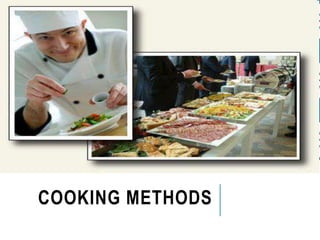
cooking methods.ppt
- 3. HEATING AND COOKING There are three types of energy central to all cooking: Conduction Convection Radiation
- 4. CONDUCTION Conduction, one of the most basic principles of cooking, is the movement of heat from one item to another through direct contact. For example, when a flame touches the bottom of a pan, heat is conducted to the pan. Generally, metals are good conductors. Copper and aluminum are the best conductors.
- 5. CONVECTION This is the transfer of heat by the movement of air or liquid Warm air that rises forces the cool air to fall then displaced back to the top when it heats up and the process is continuous. Ex. Boil water, microwave oven
- 6. RADIATION This type of heat transfer method uses infrared rays to strike and warm objects. Example the boiler heats the surface of food by radiation
- 7. WHY DO WE COOK FOOD? Improves FLAVOUR and appeal of food. Makes food safe for eating as it kills MICRO- ORGANISMS Makes food easier to chew and more digestable Destroys some of the enzymes which cause food to spoil. It thus prolongs the shelf life of food and maintains the quality
- 8. HOW DOES HEAT AFFECT FOOD? Brings out flavor and aroma Can change the color Changes the texture
- 9. CONVENTIONAL COOKING TECHNIQUES Two different types 1. Moist heat cooking: foods cooked in hot liquid or steam. It always use water. 2. Dry heat cooking: foods cooked uncovered without added liquid or
- 11. BOILING Cooking in a liquid that reached boiling point, when the liquid is producing large bubbles that rise to the surface and break. Nutrient loss is very high when using this method Suitable for pasta and corn on the cob Advantages: fast way to cook food, healthy method as it requires little or no oil, good for softening food, making it easy to chew and digest.
- 12. SIMMERING When a liquid rises gently and just begins to break the surface To simmer foods we generally bring water to a boil and then reduce the heat so that food will simmer More foods can be simmered than boiled
- 13. SPECIAL SIMMERING TECHNIQUES Stewing: involves covering small pieces of food with liquid and covering until done Poaching: involves simmering whole foods such as eggs or fruit
- 14. STEAMING A method of cooking foods over but not in boiling water. Relies on the water vapour produce by boiling water Many foods can be steamed Also it helps them retain their shape, color, flavor, and nutrients.
- 15. BLANCHING Variation of boiling. Partially cook the food and finish it later. Used a lot for vegetables. Drop in boiling water, remove before completely cooked. Shock in ice water (stops cooking).
- 16. PRESSURE COOKING This cooks food in steam under pressure and cause temps. Rise above boiling and in turn cooks food faster Best to use on foods that take a long time to cook EX. Dry beans, soups, & non tender cuts of meat
- 18. DRY HEAT METHODS Roasting & Baking Broiling Pan-Broiling Grilling Frying-sautéing, pan-frying, deep- frying
- 19. ROASTING AND BAKING Involve foods being cooked in either a conventional or convection oven Roasting usually involves cooking large tender cuts of meat Baking is the term used for cooking breads, cookies, and casseroles
- 20. BROILING Refers to food under direct heat Works well with tender cuts of meat Cooks quickly
- 21. PAN-BROILING Stove-top method of dry heat cooking. Includes foods such as hamburgers and tender cuts of steak
- 22. GRILLING Food is cooked on a grill rack above the heat source. No liquid is added. Great flavor outside, moist inside. BBQ is an example. Can use flavored wood to create great flavors in the food.
- 23. FRYING (HOT FAT) Involves cooking food in oil or solid fat Different types * Sautéing * Pan-frying * Deep-fat frying Fyi: advantages- crispy and delicious Disadvantages- use a lot of oil. The unhealthiest methods of all cooking. Uses very high temperature and destroys many nutrients.
- 24. SAUTÉING This is to brown or cook foods in a skillet with a small amount of fat. Low to medium heat is used
- 25. PAN-FRYING Similar to sautéing but usually involves large pieces of meat Food may need to be turned several times during cooking process
- 26. DEEP-FRYING AKA French Frying Food is immersed in hot fat and cooked until done. Note that fat had a “Smoke Point” this is the temperature that fat begins to break down and smoke. This means the oil is no longer good for cooking. *crispy and crunchy.
- 27. PREPARATION FOR FRYING Breading The standard Flour Egg wash Crumbs Standard breading procedure Flour Egg wash Bread Crumbs Finished Breaded Product Product to be breaded
- 28. COMBO METHODS Combining dry heat with moist heat cooking Braising Stir-frying
- 29. BRAISING This combines frying and then simmering to tenderize food and enhance flavor. Often used for less tender cuts of meat
- 30. STIR FRYING Also a combo of frying and moist heat cooking Small pieces of meat are cooked is a small amount of oil. Liquid is added throughout this process. A wok is traditionally used